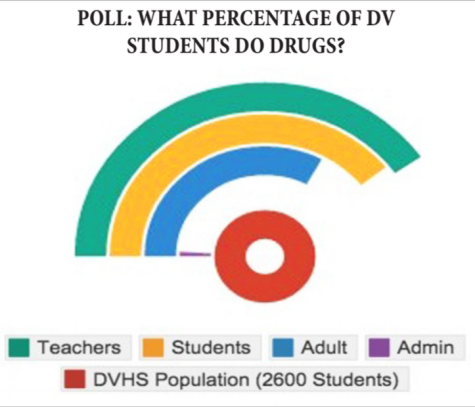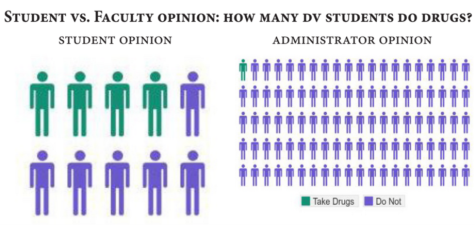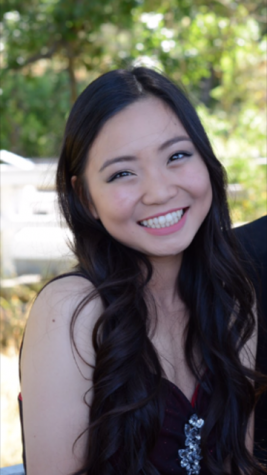Dougherty’s Reputation Takes a Hit
January 20, 2015
Over winter break, we journeyed with our friend Arnold* to one of the many secluded spots in San Ramon, away from the paved roads and orderly neighborhoods. A small fortress of nature protected us from the rest of civilization as we squatted in the dirt. The isolation of the grove was slightly unnerving. We watched him produce a glass contraption that vaguely resembled a vase, initiating both of us with our first close-up encounter with drugs.
Like many students at Dougherty, neither of us never had the time or intention to try any illicit substances, and we simply observed as Arnold exhaled a stream of white smoke. Yet Arnold certainly isn’t alone. A significant percentage of the student body has experimented with drugs; some students estimate that over half have tried.
When questioned, the people of DVHS were surprisingly open and honest about drug use. When promised anonymity or encouraged by familiarity with the interviewer, their answers were delivered with sincerity. This article would not exist without their participation, and it is their insights that formed the basis for this cursory look into a darker side of Dougherty.
THE DETAILS ON DRUGS
According to our research, the most common drugs among students at Dougherty are marijuana and alcohol. The vast majority of drug use appears limited to those two substances and vaping (which refers to using an electronic vaporizer device to inhale aerosol) as well. The rate of drug use varied significantly, but many of our subjects only do drugs on the weekends or a few times a month.
The most experienced drug users we encountered were a trio of juniors, who had tried ecstasy (also known as MDMA), salvia (a hallucinogen), LSD (a psychedelic drug) and 2C-B (also psychedelic) in addition to daily usage of marijuana. They scoffed at the idea of buying the harder drugs on campus, admitting that they associated with people of college age to acquire those. They also revealed that there were upperclassmen at Dougherty who had done cocaine, although the number was quite small. For the three juniors, future plans regarding drugs included shrooms (mushrooms with psychoactive components) and cocaine.
The locations where students did drugs were much more diverse than the drugs themselves — answers ranged from a backyard to beneath a bridge. It was universally agreed upon that doing drugs with friends was much better than doing them alone. Drugs were referred to as a cultural “bonding” moment that facilitated social interaction, or a community that transcended school.
As we expected, students refused to divulge who and where they went to for drugs. The most specific answers we received were that sources could be school friends, older kids, online dealers or clubs in other cities. Many students believed that it is relatively easy to obtain drugs if one has the desire to do so. A common price point was generally defined as $10 to $15 for a gram of marijuana, and a similar amount for a single pill of MDMA. Standardized prices could be lowered for friends or if buying in bulk. The quality of the drugs varies among dealers, although drug users most likely know their market and community well enough to discern the good from the bad.
Reasons for drug usage
The reasons behind drug use were relatively tame — we encountered no disturbed youths seeking refuge from reality. The most common motive was curiosity, as many students simply wanted to try it out and decided they liked the feeling. Many continued doing it for entertainment. One senior compared his vaping to the relaxation others felt when reading a book, or the head rush gained from drinking Monster.
A teacher offered a more profound explanation. This teacher’s opinion was that students were “trying to escape the present,” the same reason for drug use when this teacher attended high school. Another teacher believed that the people someone associated with were a significant factor when starting to use drugs, and our evidence supports this idea.
Peer pressure and the urge to fit in influence every teen’s life, and are only strengthened by the “community” of drug use. We even heard drugs being referred to as a “social platform.” One aforementioned junior, who said he first tried drugs in middle school, stated that he respected certain older kids and wanted to be more like them, and since they did drugs, he started too. A sophomore revealed that his cousins introduced him to drugs after seventh grade.
Multiple teachers were convinced that academic stress influences drug use. An administrator expressed that the need to succeed could be harsh and overwhelming for many students, and that the self-imposed psychological pressure was unnecessary. Dougherty is certainly a good school, but our excellence comes at a cost. Whether consciously or not, maybe students use drugs to seek a way to escape the workload.
Regardless of intentions, many students are aware of the risks. A junior confessed that she wanted to try shrooms and acid, but was scared of endangering herself and possibly becoming addicted. Likewise, another student feared addiction due to rumors he heard of overdoses. One senior divulged that he used to do twice as much nicotine when vaping than most people, but recently attempted to drastically lower his usage. Overall, our research found that drug use at DVHS is mild and recreational, and we heard no tales of serious harm befalling a student.
The Suppliers
We assumed that the people who would know the web of relations between drug users at Dougherty best are the ones who distribute the material — dealers. Even though they were interviewed separately, hookah pen dealers Rick* (a senior) and Davion* (a sophomore) knew each other personally and confirmed that they knew many other drug users at this school.
Rick and Davion both source their products online. Rick’s consumers are mostly freshmen. Like with many other upperclassmen interviewed, Rick believes that freshmen are mainly influenced by their peers to try drugs, and will purchase it at whatever cost.
“Freshmen want to do it … You can jack up the price because they are so desperate to buy it, so it is a lot about peer pressure,” he said.
Davion said that his customers are mainly sophomores because they know him.
“They either talk to me in person, like ‘Oh I’ve heard you do this and this’, and [I] gain their trust and make a deal with them,” he added.
Opinionated statistics to how many students at Dougherty have at least tried drugs were given with barely any hesitation. Rick said 40 percent, while Davion said at least half the student population.
“You’d be surprised [at who does it],” Davion observed.
Both dealers take drugs themselves. Rick initially tried hookah pens and now vapes regularly while Davion smokes marijuana.
Of course, dealing drugs is definitely not without its risks. A suspension, confiscation of the substances and a call home are among the most basic of punishments if caught dealing at school, according to Rick. There are even harsher consequences in the long run, such as “wrecking your job record,”
“And if you’re 18 or over, it’s prison,” he added.
Opinions on Drug Users
Every student interviewed was asked their estimate of how many students take drugs at Dougherty. The most common estimate was quite high at 40-60 percent. Many of these students did not associate with drugs or drug users whatsoever.
The interesting thing was that kids who have friends who do drugs or know more than the average student about drug use reported similar percentages, if not higher. The average consensus was 40 percent from all types of students — just under half of the student body. While this number may seem reasonable given the amount of stories and suspicions circulating around school, it must also be taken into consideration that these students may not have done the math— 40 percent of roughly 2,700 kids would mean that 1,080 students, or 2 out of every 5, take drugs regularly. The number spiked significantly higher when the question changed to the estimate of how many have at least tried drugs, or if alcohol was included as an abusive substance.
Nearly all interviewees were of sophomore class or above. Only a few freshmen were interviewed (many declined our request for comment), but those who were could not confirm if anyone in their class took drugs. Their estimates were much lower at 10-20 percent. Our survey results reveal the trend that as the grade level increases, the knowledge of drugs and drug users at the school increases as well.
Most sophomores and nearly all upperclassmen interviewed knew at least one person who openly took drugs, while most freshmen knew none. Each student’s experiences with drugs ranged greatly from the next, but all had an air of disapproval and sometimes even disgust.
Landon*, a junior, tried marijuana once or twice before quitting completely. He admits that he knows people that smoke everyday; many who are what he reported as “popular” kids who normally wouldn’t be expected to do so. He estimated that around 30 percent of students take drugs regularly, and out of the junior class alone, over a quarter have tried doing drugs.
“There’s a lot of stoners in our school, not gonna lie; once you’ve done it you’ll know how many people do it,” he commented.
However, he regards these users with disapproval, noting that “It’s their life. Like, if they want to f*** up their life, then that’s up to them, but they shouldn’t do it.”
Alfred*, a sophomore and a close friend of a few marijuana users, gave us a different perspective. As someone who is around a large group of students who are rumored for drug use, but has never been tempted to try anything himself, he confirmed his own feelings of disapprobation.
“Yeah I get associated with doing drugs — you thought I did!” Alfred said indignantly. “I don’t like it, and I don’t like anything to do with drugs … it kind of makes me mad that people think I do it because I hang out with them.”
Like many other interviewees, he estimated that a little less than half of the kids at Dougherty take drugs, and mainly do so to fit in.

Admin & teacher viewpoints
We also spoke with several teachers and administrators on the subject of drug use at Dougherty. A few teachers we interviewed tried drugs in the past, although we did not find any current users. Administration stated that no staff members had ever been caught for drug-related offenses.
There is a teacher in possession of a vaporizer, but the teacher only uses it to alleviate her oral fixation, a psychological effect of the many years spent smoking. Although surprised by how quickly word traveled, the teacher made it clear that the teacher no longer smoked cigarettes, but utilized the vape, filled with cherry-flavored liquid, to help overcome mental habits. The teacher also told us how some students thought the vape made the teacher look cool, but the teacher emphatically declared that “it doesn’t make me cool; it’s a bad thing!”
Staff were confident in their ability to detect drug use. Multiple adults cited the smell as an obvious indicator; additionally, if a student acts differently than normal, it can be cause for suspicion. One staff member stated that there was often a clear connection between drugs and students coming to class late, or not at all. Yet a teacher with experience at other schools believed that drug use was much less obvious at Dougherty compared to her observations elsewhere. Due to Dougherty’s privileged status, the teacher described the drugs as more of a “laboratory” type. The staff we interviewed did not frequently catch students for drug-related activities; the rate was usually less than one student per year.
In order to gain information from a more informed individual, we attempted to interview a campus monitor, but our request for an interview was unfortunately denied. Luckily, there was an administrator willing to talk to us.
The administrator explained that instead of just focusing on the harsh discipline and nothing else, administrators also attempt to help users overcome any problems they may have. A suspension is the common sentence, but the length can be reduced if the student opts to attend a special help service.
Opinions varied on the effectiveness and fairness of the punishments. Some adults claimed that the disciplinary system was similar to when they were younger, in addition to the substances used and the reasons for doing so. One teacher desired harsher consequences, offering additional requirements such as community service or campus work.
Another administrator we spoke with was strongly against drug use at Dougherty, and urged students to “make better decisions.” He stated that drug use has long-term consequences such as a negative influence on comprehension, logical thinking and decision-making, as well as creating a false sense of reality.
When asked what he would say if he could advise one thing to every student doing drugs, he stated: “It’s not worth it in the long run. You have your whole life ahead of you. You don’t need to do drugs to have a good time, or to deal with stress, or be cool. There are other ways [to do so].”
DOUGHERTY’s underworld
The estimates of how widespread drug usage is at Dougherty is varied. The average estimate was that roughly half of the student body had at least tried drugs. Some students, even experienced drug users, postulated that 80 or 90 percent of Dougherty students had at least tried some type of illicit substance. These statistics are in stark contrast to the estimates of some adults and younger students, which were as low as 10 percent. One teacher guessed that just 5 percent of the student body regularly do non-alcohol drugs, but when including alcohol, the number jumped to 45 percent. Although multiple estimates from adults ranged around the 40 percent mark, and even ranged as high as 70 percent, we found an administrator’s opinion particularly intriguing, who gauged that only 5 percent of students had tried drugs, and less than 1 percent were regular users.
Throughout the process of research and investigation, we learned quite a bit about a more clandestine aspect of student life, a realm of hidden secrets. The intricate, complex web of Dougherty’s dark side is complete with dealers and users of all levels and types, based on a foundation of connections. Although most students prefer to turn away from this aspect, it’s undeniable that there are a vast amount of students that use abusive substances — alcohol and marijuana amongst the most popular — and for many, their reasons include curiosity, pleasure or peer pressure. Perhaps what is most fascinating about drug use at Dougherty is that once you’ve stepped into the drug web, you’ve uncovered a whole other world that the regular student body would only have skimmed the surface of at most: Dougherty’s underworld.
The Blunt Truth
Sophomores Trish* and Bertha* believe that kids take drugs only because of peer pressure. “They think they’re really cool and weed doesn’t affect their brain chemicals or they won’t get cancer like from tobacco, but it does; it really messes up their brain. They really think it’s cool and fun,” Trish said.
“[If one of my close friends did it], I’d be like ‘dude you gotta snap out of it,’ because they might not even be doing it because they want to but because of peer pressure,” she added. “I’d be like ‘who are you hanging out with, what is wrong with you? Your life is going to go in a downward spiral!’ I feel that my reputation as a good person would go down, I would feel bad about myself that I made that bad decision.”
“I’d feel that I’m surrounded by idiots!” Bertha said.
Arthur*, a junior, took a more neutral stance. He has friends who occasionally do drugs but he doesn’t hear much about it himself, so he doesn’t seem to mind drug use. He thinks it is relatively harmless when done in moderation and understands why people would want to try, “unless it’s something extreme such as doing heavy drugs, in which case I may be somewhat wary.”
Lulu*, a freshman, said that people talked and joked about drugs and it made her uncomfortable. Marciella*, a sophomore, said that the one person she knows of had also offered her drugs before. Both had never been tempted to try drugs and disliked the thought of doing so.
Elizabeth*, a senior, has never been offered drugs, claiming, “I’ve been asking for years for someone to attempt to sell me drugs. I mean, I’ve been a target of all the school-sponsored anti-drug campaigns since I was in elementary school, and I’ve always wanted to have the opportunity to ‘just say no’ because these DARE campaigns make it seem really heroic. Unfortunately, people … don’t take me seriously. They probably think I’m an informant. I guess I’ll just wait for college.”
*Names have been changed.



